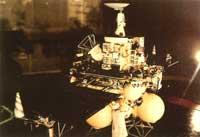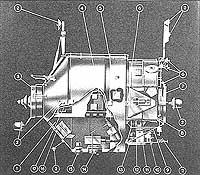Road to Mars
1989/02/01 Gluxko, B. | Semenov, J. | Gorxkov, L. Iturria: Elhuyar aldizkaria

The following question is often heard: Is it necessary to go to Mars? Some consider that on Earth we have many serious problems, so the journey of men can wait for Mars. But if we had always thought that way there would be neither Sputnik nor Juri Gagarin. In principle no one saw that space flights would benefit directly. We know he has had them now. But should we organize the trip to Mars now? Perhaps we could go back to solving our current problems. But such problems will always exist and this reasoning would paralyze the development of science and technology.
What are the technical means available today? What kind of spaces can lead man from one world to another? One of the possibilities is the interplanetary space formed by three parts: the propulsion system, the residence of the crew (where the systems of habitability and navigation and control are located) and the vehicle of the crew for Tuesday and the return to the boat.
How to go?

The spacecraft would be assembled in an orbit near Earth, using parts transported by different vehicles, probably by the Energy Launcher. After testing all the systems, the expedition would head to Mars. From four to six people will be part of the crew, which can be international.
The interplanetary vehicle would be launched from a low-level Earth orbit and would take a heliocentric orbit around the Sun that would cut the orbit of Mars. The trip would last several months. By cutting the interplanetary path to Mars, the spacecraft would begin to orbit the planet.
The landing of all interplanetary space would be laborious work. Therefore, a small vehicle would mark with all or part of the crew. Once the surface is explored, the crew must go to the interplanetary vehicle orbiting from the planet. It will go to the Earth following a path similar to the Lurra-Martitz. One option would be to take a long journey towards Venus. In this case, the expedition would need a year or a year and a half (two or three years in the other case), but fuel needs would grow a lot. This means that the mass and size of the interplanetary ship would increase and at the same time construction problems. To improve flight safety two interplanetary ships should be launched at once. If necessary, a boat crew could help them.
Drive system
One of the main problems is: Choose a propulsion system that accelerates the ship from the orbit of Earth to Mars, between the orbit of Mars and from Mars to Earth. For this you can opt for a propulsion system using liquid fuel rockets already well developed, which uses chemical energy such as the combustion of hydrogen. These systems are the most effective today and are used in the Energy launcher.

The use of chemical propulsion on the trip to Mars does not pose serious design problems. However, if we take into account that the energy need of the expedition is high and that the vehicle piloted has a greater mass than the previous robotic vehicles, we will observe that the need for fuel is enormous.
Mounting the vehicle in the Earth's orbit will be complicated. The initial mass of the vessel will be over 2,500 tons. It seems legitimate to seek more efficient energy sources, such as nuclear. In this case, the nuclear reactor produces heat and drives a gas out of the rocket vents obtaining the necessary thrust. Two or three times less propelling substances (wind gas) are needed than rockets that use chemical fuel. The initial mass of the nuclear powered vessel would be 800 tons.
The electric nuclear reactor would be even more effective. In them the reactor energy is directly transformed into electric energy. The propulsion is accelerated by an electric field to obtain the necessary impulse. In this case the amount of propulsion required is even less than that required in the previous case. The initial mass of the mission would be only 450 tons.
The boat
We will now analyze other parts of the interplanetary fleet. The most important part is that of the rooms. It is a hermetically closed module or a lot of modules, plus a cabin for the crew and a location for the instruments. The crew must supply oxygen, water and food, in addition to removing waste. The current development of this type of systems is sufficient to make an interplanetary journey.

The Living module will have communication tools with the Earth. The vehicle will have an automatic navigation and guidance system.
The comfortable temperature of the rooms will be maintained with systems similar to those used in orbital stations. Electric power can have two sources: the nuclear reactor or solar panels. To minimize the risk of cosmic rays or solar radiation that may penetrate, part of the tooling will remain inside the airtight walls of the housing module. A special shell is needed to protect the crew from the solar boiler. On orbital flights on Earth, the astronaut protects the Earth's violent magnetic fields from the sun. But on the interplanetary journey this protection does not exist and additional protection is necessary. The crew will not have to remain within the protection for the whole time, but will have to remain in it long enough (for example, during sleep) for the received radiation dose to remain at a non-dangerous level.
Another security point is protection from meteorites. On space flights, even on Earth's orbit, it is possible to find meteorites. The most effective protection is the protection of the special screen surrounding the airtight life module. When the meteorite finds the screen it becomes a jet of dust that is the only one that reaches the wall of the cabin. The walls of the Saliut and Mir stations are thus designed. The possibility of finding a meteorite with enough mass to punch screens and airtight walls is very reduced. But in this case you can also design a habitable room with separate modules. If a module is drilled, the crew can reside in the others once the communication is sealed.
Martitzar Vehicle

The third part of the interplanetary space is the marching module. To sit on the pavement you have to cross the atmosphere of Mars, so its appearance is aerodynamic. The atmospheric density on the surface of Martitz is 1% lower than that of the Earth. However, liquid fuel rockets will be used to brake the vehicle during rest. This vehicle will include a climbing rocket that will return the crew to the boat.
Back to Earth
There are several options for flying back to Earth. The vessel may use braking rockets to enter the Earth's orbit. This would be an additional product. Alternatively, the Earth's atmosphere can be used to slow down. In this case, the interplanetary space will need a special cabin and the crew will be transferred before arriving on Earth. The cabin would be separated from the space before accessing the most compact layers of the atmosphere. In the last part parachutes would be used.
When choosing the return scheme, it should be considered that Lurra is protected from possible dangerous life forms (we cannot rule out this possibility altogether). Upon their return to Earth, the crew and all objects that have had a direct relationship with Mars must be thoroughly examined. Quarantine will be long. If the crew instead of returning directly to Earth returns to an Earth orbit, quarantine can be made at the space station. The advantage of this road is the natural isolation of the land. The negative is to limit the depth of medical and biological research. If you land directly on the ground, the quarantine will be done in a module located in a hangara. In Earth's quarantine stations, deeper medical and biological studies can be performed than in orbital ones.
Do we have the necessary technology?

Now we are going to analyze to what extent terrestrial space technology is prepared for the first interplanetary flight. What problems will have to be faced before Earth representatives take the first step on another planet? One of them is the assembly of space in Earth's orbit from pieces. For 20 years the Soviet Union has had great experience in the automatic assembly of structures in space. The Soviet Union and the United States of America have coupled spaces in space.
In the mission to Tuesday it will also have to be done. Both powers have experience in interplanetary routes and aerial navigation. Automatic probes have explored peripheral and distant planets in the Solar System. Stays in orbital stations (Saliut, Skylab, Mir) have allowed the development of means for long-lasting human flights. And analyze the safety and reliability of the tooling. There will be no ground aid. Therefore, all tools and means of maintenance must be in space.
As for the puppeteer, similar problems must be addressed. America has experience in bringing and attracting a crew to the Moon. From 1969 to 1972, six times they sat on the Moon by the Apollo boats. The Soviet automatic probes are also pressed and returned on the Moon. The USSR and the US have been sent to Artizar and Mars.
The problem is that the crew remains working for a long time without gravity. For years work has been done to know him. The road has been long. At times the lack of weight for long stays in space seemed an insurmountable barrier. For example, after an 18-day flight, A. Nikolaiev and V. The remodeling of Sebiastianov to Earth was very laborious and prolonging the stay on the following flights seemed disturbing. However, by developing the cardiovascular and muscle system, the tracks have been worked so that the crew can remain for a long time without gravity. The work continues. The stay in the space station has been extended for several years. In December of last year (1987) the cosmonaut Juri Romanenko made the longest human stay without gravity (326). He returned in very good physical condition. The success of long stay flights is due to a special program of physical exercises at the station. We have reason to optimally look at the long-lasting space flight.
However, we should not oversimplify the problem. Before the big trip to Mars, space technology specialists will have to solve many technical and medical problems. Flight is not only a technical and scientific problem, it can cause the advance of terrestrial civilization.

Gai honi buruzko eduki gehiago
Elhuyarrek garatutako teknologia





